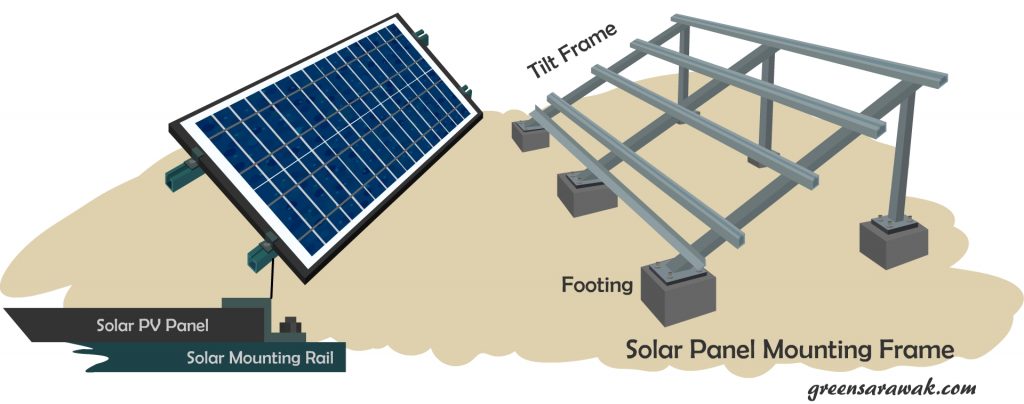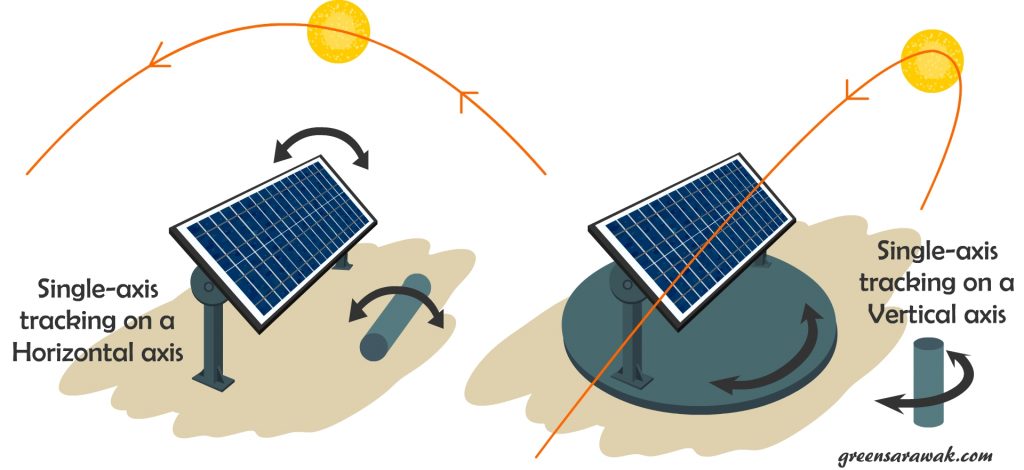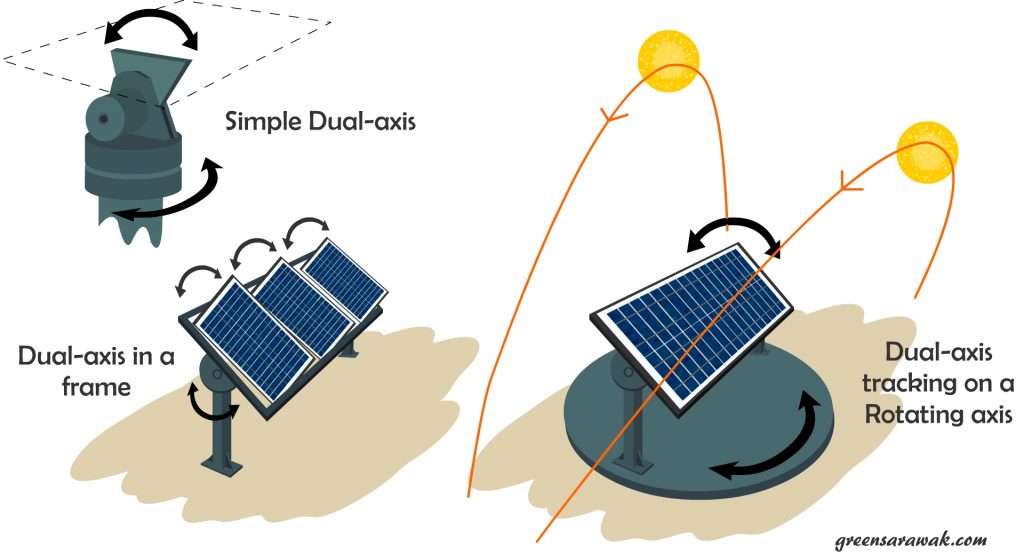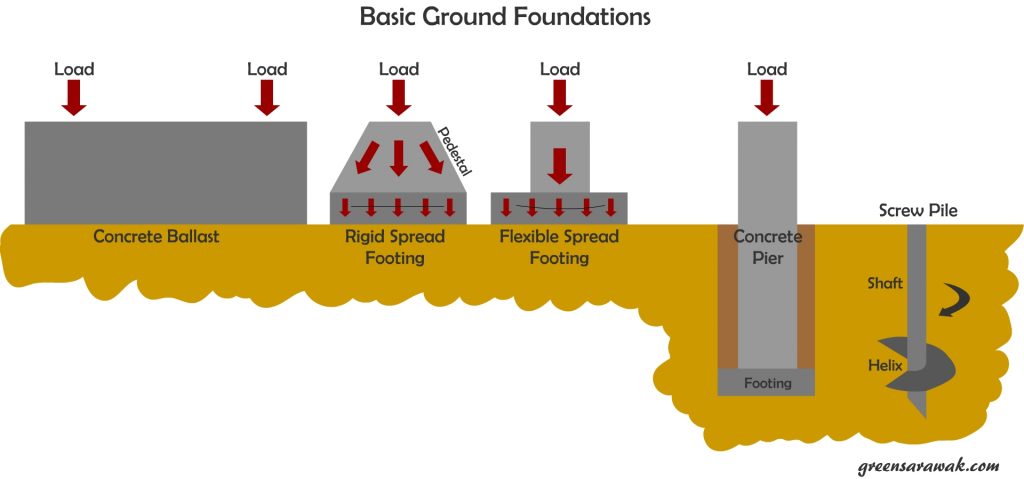Solar PV panels are usually huge and thin. They are delicate and breakable if not handled properly. Simply placing on the roof is equally as dangerous as strong wind will lift it off the roof and cause damage to the panels and the surroundings, including risk of felling onto someones head. Hence a good supports is a must, to ensure safety of both the panels and humans.
A typical solar PV panels will have most of the area occupy by the tempered glass and the solar PV cells, with a thin frame at the side. One should not directly drill and bolt the frame as it will risk damage the delicate panels. Hence there are specialized mounting available for the panels.
There is generally three type of solar PV supports.
- Fixed Solar PV panel mounts
- Adjustable Solar PV panel mounts
- Tracking Solar PV panel mounts
Fixed Solar PV panel mounts
A fixed solar PV panel mounts is the least expensive and easiest of the mounting system. It is completely stationary, that can be either roof top mounts or ground mounts.

In a roof top placement, there is solar panel mounting rails to be secured on the roof before secure the panel with a clamp on the side frames. This allow quick installation of the panels and easy for swapping of panels later on.
Depending on the roof types, some might need extra support or footing to secure the mounting rails.
The angle of the solar PV panel is also an important consideration when you want to gain most from your solar panel. The solar PV panels should always face the equator. The angle of inclination (tilt) in degrees should be set to about your latitude. Slightly more than your latitude will favor the winter sun and slightly less will favor the summer sun. In some case, extra tilt frame is need to increase or decrease the angle of the panel.
Adjustable Solar PV panel mount
An adjustable Solar PV panel mount is a mount system that allow changes in the tilt (inclination) at least twice or more over a year. This allow optimized solar power generation depends on the seasons of the year as the sun path changes over the years. A good rule of thumb is latitude + 15 degrees in the winter and latitude – 15 degrees in the summer.
The concept behind need of solar tracking is basically because there is direct lost of power if the panel is misalignment with the sun. A perpendicular panel to the sun with misalignment of 0° will lost 0% of the power. At 1° misalignment will lost 0.015%, at 8° misalignment will lost 1%. Even when the panel is align accurately during equinox, the seasonal variation (summer and winter solstice) will cause misalignment variation up to 23.4° which corresponding to 8.3% power lost. Even in the same day, there is much variation of sun angle. A panel that is align perfectly at mid day (0° misalignment) will have 15° misalignment 1 hours later (power lost 3.4%) , 30° two hours later (lost 13.4%), 45° three hours later (lost 30%), 60° four hours later (lost >50%).
Tracking solar PV panel mounts
A Tracking solar PV panel mounts is a advance mount system that allows the solar PV panel to be always facing the sun throughout the days. Usually a electric motor or linear actuator will drive the panel movements based on the sun location.
There is two main type of variant in sensing the location of the sun.
- The first type is using active light sensor that tracks the actual location of the sun and drive the motor accordingly. It will face problems when there is movement of clouds in a cloudy day where sensor will be tricked and causing delays in re-position.
- The second type is fully based on computerized algorithm that calculates the estimated location of the sun based on location of placement (e.g. via GPS to locate actual latitude and longitude), time of the day and date of the year. A computerized system can synchronize control a large field of solar PV arrays.
The tracking axis can be single axis or dual axis, with the later one more accurate in sun tracking.
A single axis tracker tracks the sun east to west and a dual-axis tracker tracks the daily east to west movement of the sun and the seasonal declination movement of the sun.
Single axis tracker cost cheaper with less maintenance and less moving parts than dual axis tracker, however the gain from the solar power generation is much less in compare to a dual axis tracker.

To reduce the cost to move every single solar PV panels with two independent motors in a dual axis tracking system, it is usually found multiple panels are group into a array.
It is estimated that dual-axis trackers can produce 45% more energy than a fixed-roof system and up to 30% more than a fixed-ground-mount system.
Dual axis tracking is very crucial in concentrator photovoltaics (CPV) and concentrated solar power (CSP) applications as the optics need to be perfectly align to collect the sun’s energy appropriately to gain maximum efficiency.

Secure Footing for a Solar PV Mounting
With a good solar PV mounting, it is also equally important to have a secure footing for the solar PV mounting to lay on.
The footing have a function to prevent the solar PV array being toppled over under strong wind and provide a level ground for the array to sit on. It also conveys the weight of the solar PV array. Single pole solar mount of either fixed or tracking variant will have extra stress on the footing.
A good foundation on a ground mounted fixed solar PV array will prevent sinking or uneven settling of the footing over time that might reduce the efficiency of the solar PV array as it will no longer facing the sun directly.
The common types of foundations used are :
- Precast or Cast-in-Place Concrete Ballast
- Concrete Pier
- Helical/Screw Piles
- Spread Footing

The concrete ballast is usually made from reinforced concrete that is cast at the site with a mold. These rectangular heavy concrete block will resist topple over just by its shear weight. It is one of the easiest to make. The concrete block also elevate the foot of the solar PV array mounts to a higher ground to reduce the chances of corrosion at the foot due to moist and direct contact with the ground.
In situation where the ground is soft, usually a concrete pier is used. This deeply pile concrete into the ground will form a strong foundation, just as the foundation for houses.
NEXT CHAPTER >> Know Your Solar Wiring
